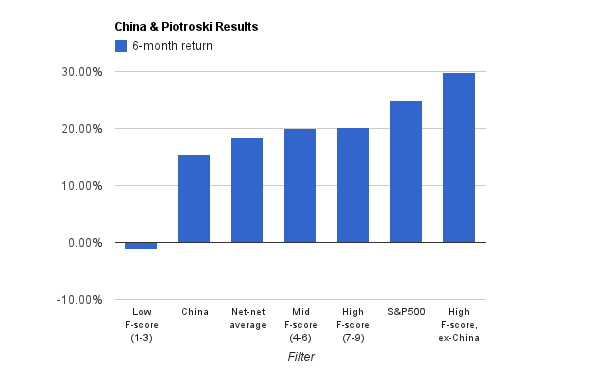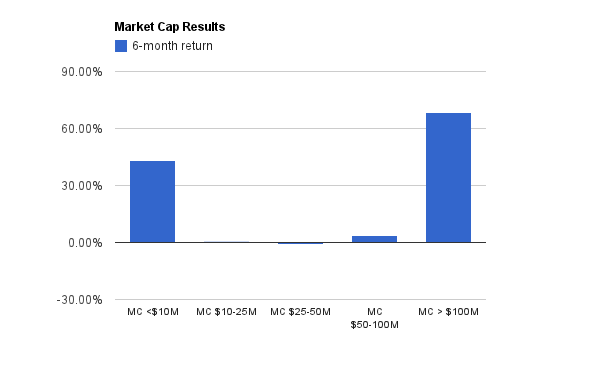Paul Sepulveda has an interesting guest post for us today. Paul dissects the recent performance of net-nets and identifies some interesting tidbits. Below I have posted the summary of his research, but if you are interested in digging into the details, here’s a link to the original Google Doc where Paul has all the underlying analysis. Very interesting stuff.
Investing in net-nets (stocks selling for ⅔ or less of their net current asset value for the purposes of this article, though othercalculations are used) is a basic quantitative value investing approach made famous by Ben Graham. I wanted to see how cigar-butt hunting worked over the past 6-months. What drove the returns? Small firms? Big firms? Chinese firms? etc. The results from the study are intriguing, but because of the short sample period and volatility in returns, it is hard to make bold claims from the data.
I initially investigated net-net companies to see if it would be possible to improve average returns by removing firms with the highest likelihood of going to zero (the real losers). My goal was to chop off the left tail of the distribution of returns. Piotroski uses his F-Score to achieve a similar goal among a universe of firms with low P/B (i.e., “value” firms). After collecting the data on recent net-net “cigar-butts”, I quickly realized something: about half of my list consisted of Chinese reverse-merger companies! These firms definitely had a decent shot of going to zero after shareholders realized Bernie Madoff was the CEO and Arthur Anderson was performing the audit work. I separated these companies from the remaining universe. For completeness, I also recorded market caps and Piotroski scores to create alternative net-net universes I could study.
After a bit over six months of tracking net-nets, I finally had some initial results. The evidence was surprising. Non-Chinese companies slightly outperformed Chinese companies and high Piotroski score stocks outperformed the lowest scoring (especially after screening out Chinese companies). However, the most dramatic results were size-related.
Figure 1

The results are hypothetical results and are NOT an indicator of future results and do NOT represent returns that any investor actually attained. Indexes are unmanaged, do not reflect management or trading fees, and one cannot invest directly in an index. Additional information regarding the construction of these results is available upon request.
I separated the sample companies by market cap into five size categories: under $10M, $10-25M, $25-50M, $50-100M and over $100M. Companies at the top (>$100M) and bottom (<$10M) of the size range outperformed the companies in the 10-100mm category (essentially flat). Both the <$10M and >$100M significantly outperformed other filters in the sample period. One caveat is the portfolio size for each of these size buckets: the size portfolios have a range of 5 to 19 stocks in each category. Nonetheless, the anecdotal evidence in Figure 2 is striking.
Figure 2

The results are hypothetical results and are NOT an indicator of future results and do NOT represent returns that any investor actually attained. Indexes are unmanaged, do not reflect management or trading fees, and one cannot invest directly in an index. Additional information regarding the construction of these results is available upon request.
Figure 3 highlights the 6-month returns for a variety of strategies formed from the universe of net-net firms. In general, the results are intuitive: High F-score outperform low F-score, Chinese shell companies perform poorly, net-nets as a group have solid performance, etc. However, the larger net-nets outperform all other cuts of the data. This result seems odd. We would expect firms <$10M to be undervalued due to lack of visibility or liquidity, however, the larger firms in this small sample actually outperform their smaller, more illiquid brethren.
Figure 3

The results are hypothetical results and are NOT an indicator of future results and do NOT represent returns that any investor actually attained. Indexes are unmanaged, do not reflect management or trading fees, and one cannot invest directly in an index. Additional information regarding the construction of these results is available upon request.
The results from this net-net study are promising, but it’s obviously a little early to celebrate. There are a few basic issues to consider:
- The best-performing net-nets represent a small subset of the net-nets sample (the net-net sample is already a small group of 56 companies).
- Short sample period (6-months).
- Transaction costs would definitely impact returns, especially for the tiniest firms. I used the http://www.grahaminvestor.com/screens/graham-ncav-stock-screen-new/ screening tool, which did not include OTC stocks, but even micro-cap NASDAQ/AMEX/NYSE firms can be plagued with terrible liquidity.
Despite the caveats on this study, the results thus far suggest the larger net-nets do the best. It will be fascinating to see how this plays out in the future. I’m already keeping tabs on another set of firms I recently pulled from the net-net screen and I’ll report on their performance in 6-months. For anyone who’s interested, here’s a link to the original (slightly cluttered) Google Doc where I started recording this: link.
======================================================================================================
Thanks, Paul. We look forward to your work in the future!
About the Author: Wesley Gray, PhD
—
Important Disclosures
For informational and educational purposes only and should not be construed as specific investment, accounting, legal, or tax advice. Certain information is deemed to be reliable, but its accuracy and completeness cannot be guaranteed. Third party information may become outdated or otherwise superseded without notice. Neither the Securities and Exchange Commission (SEC) nor any other federal or state agency has approved, determined the accuracy, or confirmed the adequacy of this article.
The views and opinions expressed herein are those of the author and do not necessarily reflect the views of Alpha Architect, its affiliates or its employees. Our full disclosures are available here. Definitions of common statistics used in our analysis are available here (towards the bottom).
Join thousands of other readers and subscribe to our blog.

